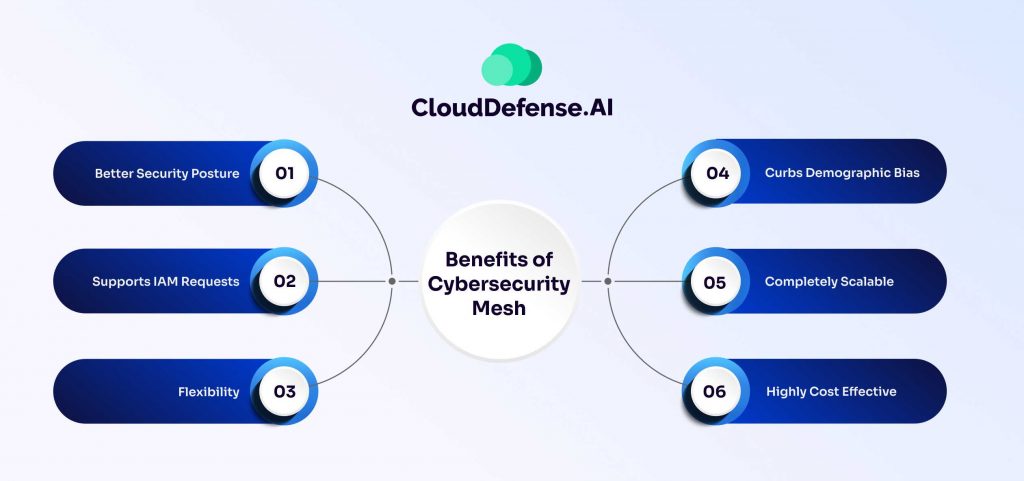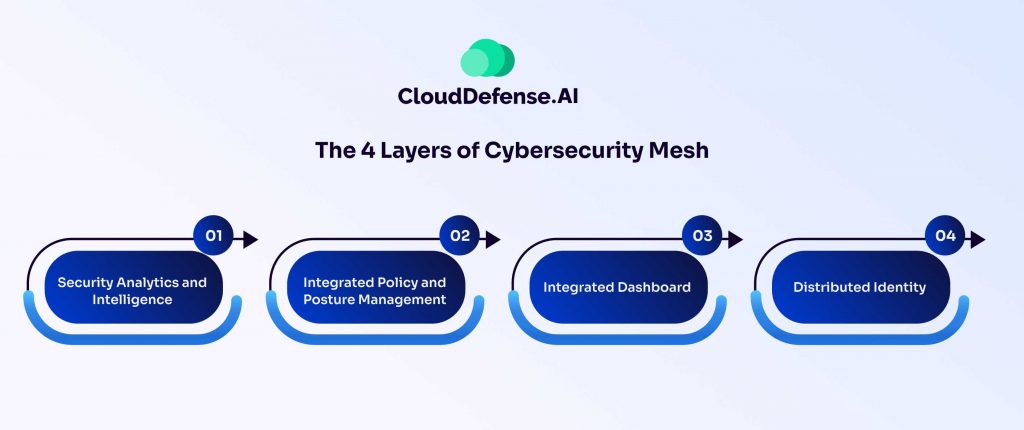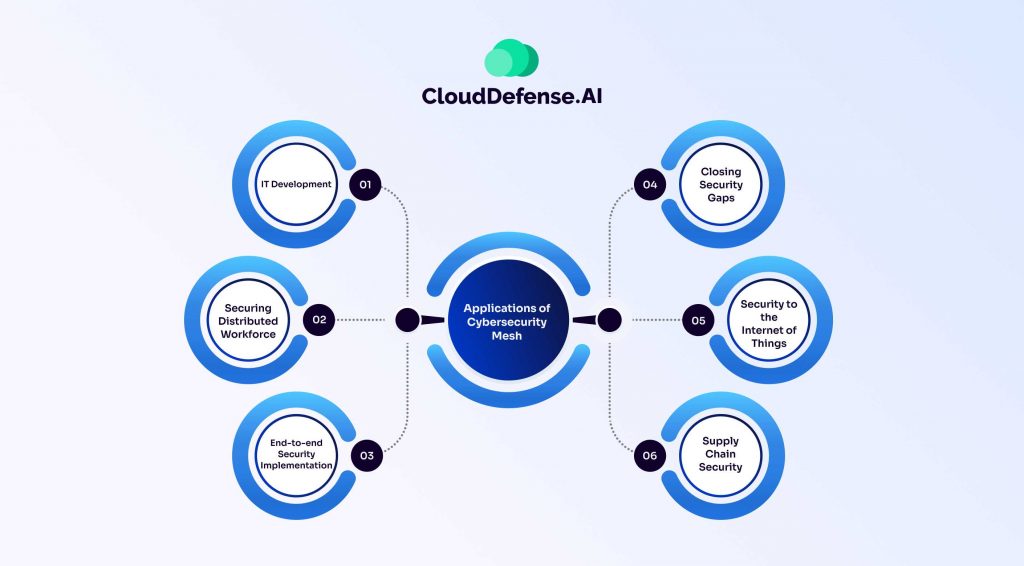With increasing demand for distributed technology and modern technology becoming more fragmented, it has become necessary for cybersecurity experts to look for advanced cybersecurity.
Moreover, with the increase in reliance on the cloud, the number of cybercrimes is also increasing, and organizations are requiring better approaches that will ultimately secure their data and sensitive information.
To fill this void, a cybersecurity mesh came into existence. It serves as a scalable and flexible architecture that allows users to access all the digital assets. In this article, we are going to take a detailed look at what a cybersecurity mesh (CM) is and understand how it can be beneficial for your organization.
What is Cybersecurity Mesh (CM)?
Cybersecurity mesh is a modern architectural and distributed approach that enables the organization to secure every device independently with firewall and network security tools.
With the increase in the trend of remote working models, organizations have had to take a new security approach that will enable them to take a holistic approach towards securing the IT environment. According to Gartner, cybersecurity mesh is a defined collaborative ecosystem where various controls and tools work together to secure the distributed network.
CM is basically a flexible architecture that integrates distributed security and composable security services to maximize detection capabilities, response efficiency, and granular access control. It helps organizations create individual parameters around each access point and enables users to access all the data securely.
Importantly, through cybersecurity mesh, the organization can easily manage each endpoint from a centralized security panel and allow the organization to operate securely from anywhere in the world. CM follows a zero trust security strategy where it allows users and machines to security access data, services and devices from anywhere with proper identity authorization.
Cybersecurity Mesh Example
Cybersecurity mesh is all about offering comprehensive and flexible security to all digital assets by extending security controls. Here are some popular examples that will give you a brief idea regarding this distributed security approach.
Siloed Technology
Many organizations rely on siloed security solutions, but the biggest issue with this kind of technology is the requirement for data analysis. Moreover, organizations using tools from various vendors interacted with each other for sharable intelligence.
However, cybersecurity mesh solved this issue by allowing all the tools to work together rather than individually and share all the data related to security analytics. It prevents all the security tools from running in siloes and enables sharing of security intelligence.
Decentralized Security Access Points
Previously, organizations had a centralized security solution for all the devices, devices, and endpoints in their digital infrastructure. However, the main issue with such a security solution is that it doesn’t offer individual security to endpoints that are remotely accessed by users or machines.
With the arrival of CM, organizations were able to distribute the security across various nodes in the IT ecosystem. This approach allowed the creation of individual parameters around each endpoint and elevated the overall security posture.
Identity Centric Security Parameter
Zero trust strategy is based on an identity-centric security model that leverages users’ authentication and authorization capability for access. However, this strategy is quite time-consuming as it encompasses a lot of verification processes. CM streamlines this strategy by bringing identity-centric security.
Benefits of Cybersecurity Mesh

Adopting a cybersecurity mesh brings many benefits for organizations where each benefit is meant to strengthen overall security posture. Here are the key benefits:
1. Better Security Posture
The adoption of CM enables your organization to create a secure perimeter around each device and identity and limits the chances of a spread of the security breach.
Since it establishes isolation for each device and identity, it is able to limit the damage to the compromised device alone. Thus, it is able to elevate the overall security posture of the organization by a large margin.
2. Supports IAM Requests
It becomes difficult for organizations to safeguard various identities, devices, and digital assets that operate outside the organization’s security premises.
In today’s world, where remote working is the latest trend, organizations relying on traditional security architecture are finding it challenging to manage IAM requests. However, CM helps handle most of the IAM requests and allows for reliable digital asset access and control.
3. Flexibility
A huge benefit of adopting cybersecurity mesh is the flexibility it offers. It allows users to customize depending upon the requirement of the device’s and identity’s security. CM enforces necessary security controls that are needed to safeguard the device.
4. Curbs Demographic Bias
With the increase in remote working, organizations followed a document-centric approach for identity proofing, and it was becoming problematic for them due to an increase in bias. However, the adoption of CM was able to reduce the demographic bias and allow users to access data without any issues.
5. Completely Scalable
An organization, with time, is going to expand, and so are its security controls and parameters. Organizations leveraging cybersecurity mesh won’t have scalability issues because it can add new identities and devices and adapt to the growth. It is inherently scalable and will expand the mesh as the organization grows.
6. Highly Cost Effective
Another huge reason behind the large-scale adoption of CM is its cost-effective nature. Your organization only has to pay for the amount of security measures you need. When your organization scales, it enables you only to pay for the additional requirement, thus preventing you from additional expenditure.
Cybersecurity Mesh Architecture
A cybersecurity mesh architecture is all about promoting coordination and interoperability among security products in the network and enabling better security policy. It provides organizations better flexibility and a distributed approach towards the security of the devices and identity.
Instead of protecting all the devices and identities in the network through a single security solution, it enhances the overall security by safeguarding individual endpoints in the network.
The adoption of this architecture allows organizations to ditch traditional security systems and embrace an integrated security approach that will enable users to access data from anywhere. One of the most significant benefits of cybersecurity mesh architecture is that it makes the security posture more agile by offering scalable and flexible security responses.
By design, CMA enables security services to integrate and communicate with each other and enhance the dynamicity of the security measure. This architecture also helps create a medium where all the security technologies and solutions can be easily deployed and managed.
When an organization implements cybersecurity mesh architecture, it promotes collaboration between integrated and analytical tools, which helps them respond to attacks and incidents in a better manner.
The 4 Layers of Cybersecurity Mesh

Cybersecurity mesh offers organizations four vital layers that enable them to provide better responses to security incidents. These four layers are:
Security Analytics and Intelligence
Cybersecurity mesh allows for a centralized administration where all the data are collected and analyzed in real-time. Since all the data are located centrally, it helps in better threat response, risk analysis, and remediation of issues that might arise. Using data analysis and security lessons, CMs are able to analyze threats in a better manner and provide appropriate responses.
Integrated Policy and Posture Management
With the ability to convert a central policy into the configuration of a security tool, it helps the responsible team to discover misconfigurations and compliance risks more effectively.
Integrated Dashboard
CM provides organizations with an integrated dashboard through which security teams can get a complete view of their security posture. This integrated dashboard enables organizations to respond to security events quickly and deploy responses as soon as possible.
Distributed Identity
Distributed identity is an essential aspect of cybersecurity mesh because it puts forward access and identity management that are part of the zero-trust policy. Basically, it provides organizations with adaptive access, decentralized identity management, directory services, and identity proofing.
How Does Cyber Security Mesh Work?
A cybersecurity mesh, when implemented in an organization’s IT environment, builds an integrated network of security devices, services, and applications. Each of the integrated components in the network works together to safeguard each endpoint and device connected to the network.
Basically, it creates a specific and individual parameter around each endpoint and device in the network by leveraging network protection tools and firewalls. For access, CM evaluates the location, user behavior, and device health, and depending upon all these factors, it minimizes the chances of a security breach.
Once a CM is implemented on the entire network, it works towards building a flexible security environment, which ultimately helps in the easy implementation of identity-proofing tools.
Applications of Cybersecurity Mesh

The number of applications associated with cybersecurity mesh is pretty significant, and the type of applications span various domains in the industry. The huge number of applications has enabled the solution to be more adaptable and flexible for enhancing the security posture. Here are some popular applications of CM:
IT Development
Many organizations from the IT domain are adopting cybersecurity mesh because it enables them to centralize the entire security policy management and operate everything from a single plane. Most importantly, this strategy is entirely agile and can scale according to the requirement.
Securing Distributed Workforce
Cybersecurity mesh, with its unique strategy and distributed security architecture, enables an organization to secure its distributed workforce. It allows employees to work from anywhere in the world while securely accessing data, applications, and machines.
End-to-end Security Implementation
Cybersecurity mesh architecture is highly instrumental for implementing end-to-end security, covering each endpoint in the network. When the four layers of CM are implemented, it helps in mitigating all the security issues and provides comprehensive coverage.
Closing Security Gaps
One of the significant applications of CM is that it has helped many organizations to learn and adapt to the latest security trends and implement them to stay ahead of the curve.
It helps them to adapt to the ever-evolving cybersecurity and close gaps that might have been exploited with the latest cyber attacks. With CM, vulnerabilities and security gaps are detected in the early stage.
Security to the Internet of Things
With the increase in the Internet of Things, there was a huge requirement to secure a variety of connected devices in the network. Cybersecurity mesh came as a perfect solution where it is able to secure each IoT endpoint, communication channel, and gateway.
Supply Chain Security
Cybersecurity mesh has been instrumental for organizations to elevate the security of their supply chain. It secures data exchange points among various components and enforces security controls on digital communication in the supply chain. Thus, altogether, it curbs down the chances of security incidents in the supply chain.
Futures of Cybersecurity Mesh
Cybersecurity mesh is currently an emerging technology and security solution in the industry, and many organizations are rapidly adopting it. The widespread adoption of cybersecurity mesh in the future promises a revolution regarding how organizations consider the security of their endpoints, data, and devices in the network.
Even though CM has reduced the number of cyberattacks on an organization, it still has yet to get its fair share of popularity in the industry. In 2009, Google developed the BeyondCorp framework, but no one adopted the Zero Trust strategy.
It took organizations almost a decade to understand the impact Zero Trust strategy can have on their cybersecurity. Gartner predicted that by 2024, organizations that will implement cybersecurity mesh in their network will substantially curb the effects of cyber attacks and incidents.
Organizations are slowly realizing the benefit of CM, and as more organizations start adopting it, this security solution will gradually reach a considerable market size. According to a report, the global market size of CM can reach up to 7.21 Bn by 2029 with an expected CAGR of 29.2%.
Top vendors like IBM Corporation, Palo Alto Network, Check Point Software Technologies, Zscaler, Fortinet, etc, are making efforts to popularize cybersecurity mesh in the industry. According to various sources, North America is expected to see the largest number of adoptions in the global market.
Cybersecurity Mesh Trends 2025
Based on the rapid popularity of cloud technology and changes in the threat landscape, here are some anticipated cybersecurity mesh trends of 2025:
Supply Chain Risk
The attack on the supply chain risk will remain a predominant trend in 2025. The increase in hybrid work environments and distributed networks will serve as the main cause of the increase in attack surface.
In 2025, a large number of employees will work from home, and this will increase the chance of cyber attacks on the supply chain. A report has stated that more than 50% of employees prefer to work from home, and around 18% of workers have decided to avoid going to the office permanently.
Generative AI in Attacks
The rise of generative AI in 2025 will significantly impact the cybersecurity mesh and increase the chance of successful security breaches. Attackers are utilizing generative AI tools to carry out different types of attacks and compromise devices or identities in the network.
Automated malware to deepfake social engineering approaches is becoming a serious threat to cybersecurity mesh. However, generative AI is also strengthening CM to identify potential risks and detect real-time anomalies and other attacks.
IoT Cyber Attacks
The increasing accessibility of the internet in devices and interconnectivity among devices in distributed networks will result in the rise of IoT cyber attacks.
The rise of work-from-home culture will also increase cyberattacks as users will utilize insecure equipment for sharing data. Since these devices don’t have many security measures, it will potentially impact the cybersecurity mesh and make the IoT devices vulnerable to attacks.
Rise of Attacks on Identities
In 2025, there will be a significant rise in attacks on identities and credentials of the users in a network. Attackers will try to exploit the identity and credentials of a user to gain access to the distributed network and harm the cybersecurity mesh.
It is expected that attackers will also hamper identity and access management and allow themselves to gain entry into the distributed network.
Expanding Attack Surface
With the increase in distributed networks, the attack surface will significantly increase in 2025. Even though the adoption of cybersecurity mesh has reduced the attack surface in many distributed networks. But the expanding use of insecure devices in a distributed attack will increase vulnerability and will ultimately widen the attack surface.
Expansion of the Zero Trust Principle
As the threat landscape will continue to expand in 2025, the Zero Trust principle is also expected to expand the scope beyond the traditional business network. It is expected to cover a larger ecosystem that encompasses remote work devices, IoT devices, and affiliated enterprises.
It is estimated that by 2025, the Zero Trust principle will undergo a major transformation where it will expand its reach from just being a network security model to a broader environment. The adoption of automated authentication and activity monitoring will aid in the expansion of the Zero Trust principle.
FAQ
What is zero trust vs mesh cybersecurity?
Cybersecurity mesh is a building block of Zero Trust that helps organizations to individually secure devices with their own perimeter in a network. It uses a holistic approach where each device and endpoint gets its security.
Zero Trust, on the other hand, serves as a cybersecurity approach that prevents users from accessing an organization’s assets by default. It only allows users to access an organization’s digital asset once it varies and authenticates the user.
Why do we need cybersecurity mesh?
Cybersecurity mesh is currently a demanded security solution in the industry that helps organization safeguard their digital assets from malicious actors. It creates a secure network of interconnected devices where each endpoint and device is secured individually with its perimeter.
Where is cybersecurity mesh used?
Cybersecurity mesh is utilized by organizations with large supply chains and distributed networks. Organizations with multi-cloud environments and edge computing networks widely use cybersecurity mesh to protect their devices and endpoints from malicious actors.
Conclusion
In today’s world, where cyberattacks are evolving day by day, cybersecurity mesh has emerged as an effective solution to most cyber incidents. Even though cybersecurity mesh is yet to become popular, the adoption of this holistic approach is increasing gradually.
This article provides a detailed outlook regarding CM and how it can benefit your organization. We have supplied all the necessary details along with the latest trends regarding CM so you can be aware of this security strategy.







